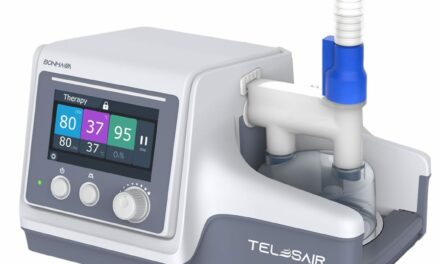Engineering researchers have used computational modeling to show that noninvasive respiratory support is more likely to be successful if it allows significant reductions in patients’ breathing efforts, according to a study published in the British Journal of Anaesthesia.
The study is the first to use computational modeling to compare the effectiveness of conventional oxygen therapy (COT), high-flow nasal oxygen therapy (HFNOT), continuous positive airway pressure (CPAP), and noninvasive ventilation (NIV). Researchers used computational simulations of 120 COVID-19 patients to quantify the internal mechanical forces that are produced by different types of noninvasive respiratory support at different levels of breathing effort.
The team of experts found that, although noninvasive respiratory support improved patient oxygenation, stresses and strains inside the lung could be increased to potentially damaging levels unless significant reductions in breathing effort occurred.
To try to avoid the risks associated with mechanical ventilation, many COVID-19 patients are initially treated using CPAP, HFNO, or NIV. These therapies can be delivered outside the ICU, using face masks or nasal canulae, while the patient is awake and spontaneously breathing.
It is currently not clear why some patients respond well to noninvasive respiratory support and improve, while others continue to deteriorate and eventually need to be put on a mechanical ventilator. Clinicians worldwide are conducting clinical trials to better understand how noninvasive respiratory support can best be used to treat patients.
According to their published results:
- HFNOT, CPAP, and NIV improved oxygenation compared with conventional therapy, but also initially increased total lung stress and strain.
- Improved oxygenation with CPAP reduced respiratory effort but lung stress/strain remained elevated for CPAP >5 cm H2O.
- With reduced respiratory effort, HFNOT maintained better oxygenation and reduced total lung stress, with no increase in total lung strain.
- Compared with 10 cm H2O PEEP, 4 cm H2O PEEP in NIV reduced total lung stress, but high total lung strain persisted even with less respiratory effort.
- Lung-protective mechanical ventilation improved oxygenation while minimizing lung injury.
“There is concern that strenuous breathing can further damage the lungs of COVID-19 patients. Our study found that reductions in patients’ breathing efforts after commencing noninvasive respiratory support could be a key-indicator of its likely success,” said coauthor Dr. Luigi Camporota, a consultant in intensive care medicine at Guy’s and St. Thomas’ Hospital London. “These results provide urgently needed evidence to help clinicians manage and optimize the treatment of COVID-19 patients in a way that averts additional and preventable lung injury.”
The next steps for this research are to further refine the computational models using large-scale patient data collected over the course of the pandemic, and to conduct more detailed simulations of the most promising non-invasive therapies.
“Many COVID-19 patients who experience acute respiratory failure are initially treated using some form of noninvasive respiratory support to help them breathe and avoid the need for mechanical ventilation. This study shows the power of computational simulation to rapidly answer questions that are directly relevant to the treatment of critically ill patients,” said Professor Declan Bates, from the School of Engineering at the University of Warwick.










